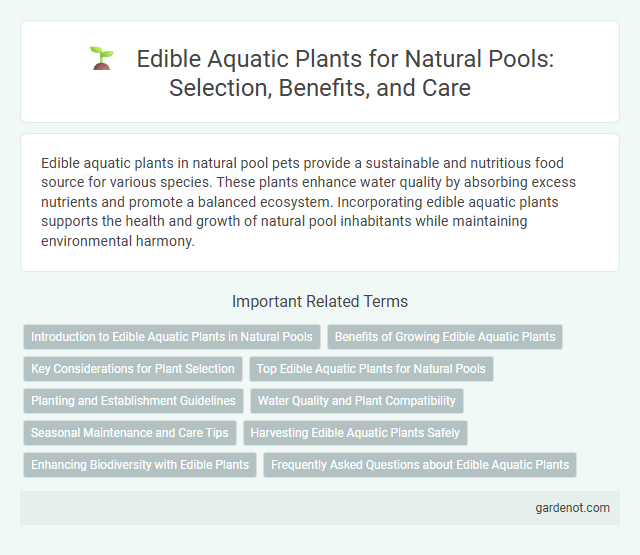Edible aquatic plants in natural pool pets provide a sustainable and nutritious food source for various species. These plants enhance water quality by absorbing excess nutrients and promote a balanced ecosystem. Incorporating edible aquatic plants supports the health and growth of natural pool inhabitants while maintaining environmental harmony.
Introduction to Edible Aquatic Plants in Natural Pools
Edible aquatic plants in natural pools provide both ecological benefits and unique culinary opportunities, contributing to water purification and habitat diversity. Common species such as watercress (Nasturtium officinale), water spinach (Ipomoea aquatica), and wild rice (Zizania spp.) thrive in these environments, offering essential nutrients like vitamins A and C, iron, and antioxidants. Integrating edible aquatic plants in natural pools enhances sustainability by supporting biodiversity and promoting natural water filtration processes.
Benefits of Growing Edible Aquatic Plants
Growing edible aquatic plants in a natural pool enhances water purification by absorbing excess nutrients and reducing algae growth, promoting a balanced ecosystem. These plants provide a sustainable source of fresh, organic food rich in vitamins and minerals, supporting dietary health and self-sufficiency. Their root systems stabilize pool substrates, preventing erosion while creating habitats for beneficial aquatic organisms.
Key Considerations for Plant Selection
Selecting edible aquatic plants for a natural pool requires careful evaluation of growth habits, water quality benefits, and compatibility with other species. Emphasize plants like watercress (Nasturtium officinale) and wild rice (Zizania aquatica) that thrive in clean water, provide nutrient filtration, and support local biodiversity. Consider factors such as sunlight requirements, water depth tolerance, and potential invasiveness to maintain ecological balance and ensure sustainable harvest.
Top Edible Aquatic Plants for Natural Pools
Top edible aquatic plants for natural pools include watercress (Nasturtium officinale), known for its peppery flavor and rich vitamin content, and duckweed (Lemna minor), which is high in protein and can be harvested sustainably. Lotus (Nelumbo nucifera) offers edible seeds and roots with nutritional benefits such as antioxidants and essential minerals. Water chestnut (Eleocharis dulcis) produces crisp, starchy tubers commonly used in Asian cuisine, making these plants ideal for enhancing both the ecology and edibility of natural pools.
Planting and Establishment Guidelines
Selecting native edible aquatic plants like watercress (Nasturtium officinale) and water mint (Mentha aquatica) ensures seamless integration into natural pools. Plant in nutrient-rich, well-drained substrates at water depths between 10 to 30 cm to promote healthy root establishment and optimal growth. Maintain consistent water levels and moderate sunlight exposure during the initial weeks to support plant acclimation and prevent stress or dieback.
Water Quality and Plant Compatibility
Edible aquatic plants such as watercress and duckweed improve water quality by naturally filtering pollutants and providing oxygen through photosynthesis, aiding in maintaining a balanced ecosystem in a natural pool. Their compatibility with other aquatic flora depends on growth rates and nutrient needs, ensuring they do not outcompete beneficial species while supporting biodiversity. Proper management of these plants helps prevent algae overgrowth and promotes clear, nutrient-rich water conducive to healthy aquatic life.
Seasonal Maintenance and Care Tips
Seasonal maintenance of edible aquatic plants in a natural pool involves regular pruning during spring to encourage healthy growth and prevent overcrowding. Monitor water temperature and nutrient levels in summer to optimize plant health and reduce algae competition. In autumn, remove decaying foliage to maintain water quality and prepare plants for winter dormancy.
Harvesting Edible Aquatic Plants Safely
Harvesting edible aquatic plants requires careful identification to avoid toxic species and contamination from polluted water sources. Use clean tools and avoid uprooting entire plants to promote sustainable regrowth, targeting mature parts like leaves or stems. Regular testing of water quality ensures the plants remain safe for consumption, minimizing health risks associated with heavy metals or pathogens.
Enhancing Biodiversity with Edible Plants
Edible aquatic plants such as watercress, duckweed, and water spinach play a vital role in enhancing biodiversity within natural pools by providing habitat and food for various aquatic species. These plants contribute to water quality improvement through nutrient absorption, supporting a balanced ecosystem that attracts beneficial insects, amphibians, and birds. Integrating diverse edible aquatic plants promotes sustainable natural pool management while offering a unique source of fresh food.
Frequently Asked Questions about Edible Aquatic Plants
Edible aquatic plants such as watercress, lotus root, and water chestnuts thrive in natural pools, providing both aesthetic value and nutritional benefits. Common questions include how to identify safe species, their nutritional content, and the best harvesting techniques to avoid contamination. Proper knowledge ensures sustainable use and enhances the ecosystem's biodiversity while offering fresh, organic food sources.
Edible aquatic plant Infographic

 gardenot.com
gardenot.com